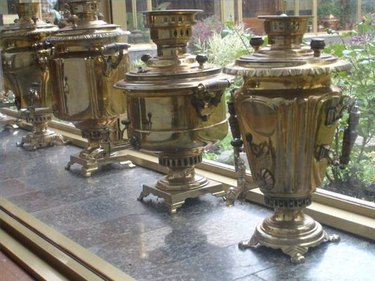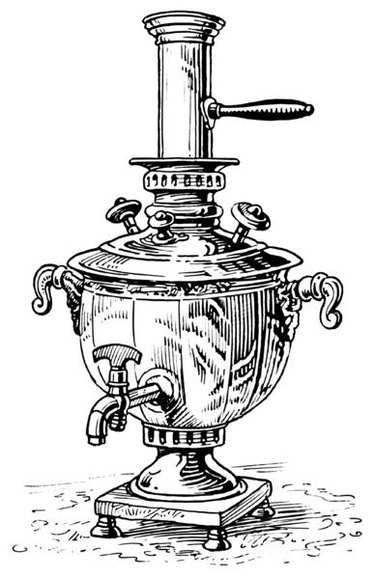
A samovar is a container used to heat and boil water. Samovars appeared in the 18th century and are thought to have been invented in Russia, although this is disputed. They are typically made from metal, including iron, brass, copper and bronze, according to the website of The Lower East Side Restoration Project. Antique samovars can cost thousands of dollars.
Anatomy
Video of the Day
Samovars range in design from simple to ornate, and they come in a variety of shapes, colors and sizes, but there are some basic elements common to each one. All nonelectric samovars have a vertical tube in their center called the pipe, or the chimney. If you think of the samovar as an engine, then the pipe is the combustion chamber, where the fuel is burned. The body, which surrounds the pipe, holds the water. Most samovars also have a warmer, a space on top to hold and keep a teapot warm. Hot water flows from the samovar through a simple spigot, also called a valve.
Video of the Day
Combustion

"A samovar shining bright in the sunlight is a sign of hospitality and good manners of the party's host," according to Dániel Nagy, who wrote a document called "Russian Tea HOWTO for Linux Hackers." To heat water in a samovar, according to Nagy's instructions, fill the body with water and the pipe with charcoal (or dry pine cones, or some other combustible material). To ignite the fuel, you can use a newspaper. Help the fire by pumping the tube. Samovars come with two accessories: a cap and a chimney extension. When the fire gets going, attach the chimney extension to the tube. When the pipe gets hot, it heats the water. When the water boils, remove the chimney extension and cover the tube with the cap. Then pour hot water, as needed, from the spigot.
Electric samovars, first introduced in the 1950s, operate on the same principles, but without the need for fuel.
Consumption
The Russian method is to prepare a very strong tea, called zavarka, in the teapot. The strong tea is then poured into cups and diluted with water from the samovar. A less traditional method would be to pour water from the samovar over a teabag in a cup. Remember to never brew tea inside the samovar.